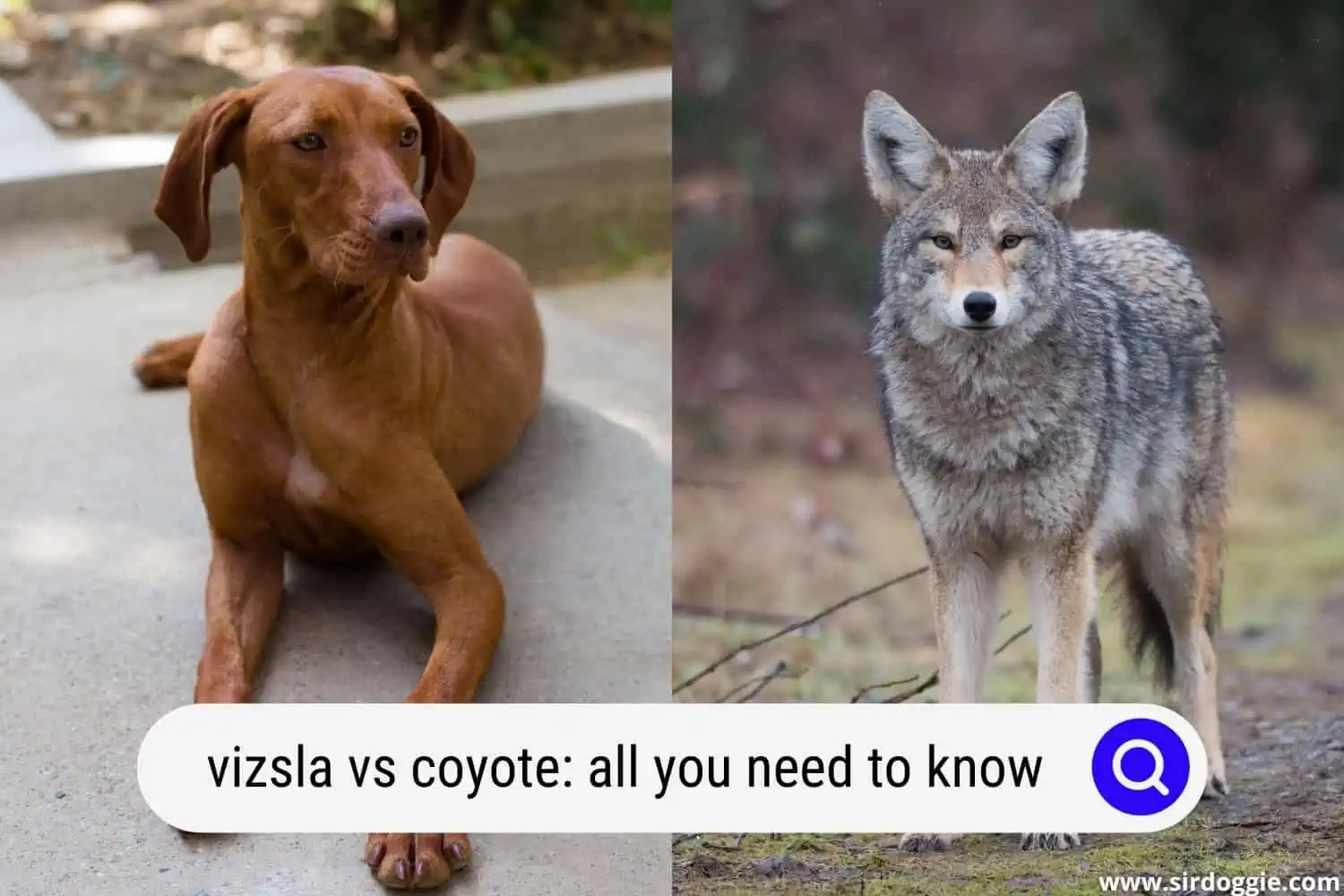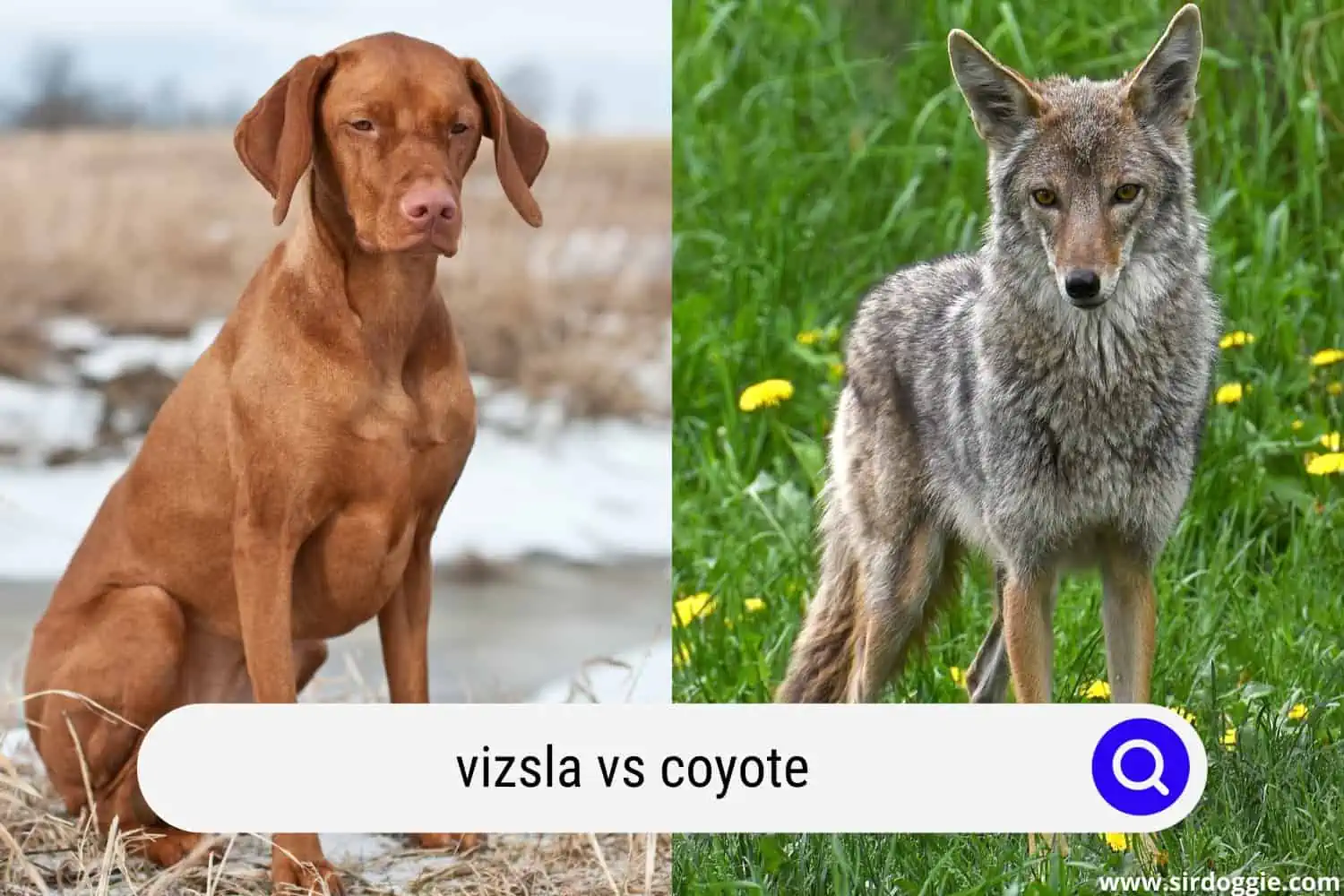Vizsla vs Coyote: All You Need to Know
We often hear stories told by Vizsla owners of encounters between coyotes and the Hungarian pointer. Coyotes are known for jumping fences and killing small dogs. In a pack, your pet may have a hard time facing its sworn enemy from the same canine family. But what are the chances a Vizsla dog has with a lone coyote?
In this Vizsla vs coyote comparison article, we’ll take a look at both canine members as well as the possibility of taking one as a pet, if you dare to.

The Vizsla or Hungarian Pointer
The Vizsla dog breed, also known as the Hungarian Pointer, is characterized by being strong, thin, fast, and very beautiful. It is a dog with a loyal, affectionate, and very energetic character.
Character of the Vizsla
In either of its two varieties (short hair or wire hair), the character of the Vizsla is that of an affectionate, energetic, and loyal dog. For the dog, any occasion is good to show its gentle, funny behavior and it is a good family companion.
Popularly known as the versatile Vizsla, this is one of the most elegant dogs in the world. It has achieved great popularity throughout the world thanks to its hunting qualities and its excellent temperament.
Among its virtues, in addition to a great capacity for work, especially in the hunting field, it searches and charges at a very high level. Its intelligence and ease of learning also allow it to participate in many sports and canine competitions.
Apart from its good aptitude, its great adaptability and low maintenance make it a suitable choice for a wide range of families.
The Hungarian Pointer is loyal and easy to train. However, rough training can cause aggressiveness or withdrawal.
Its friendly nature makes it an excellent dog for the home and adapts to the most diverse physical environments. It also has a great sense of smell.
Physical characteristics of the Vizsla
Speaking exclusively of its body, the Vizsla has a slightly elongated build, with a deep and robust chest, and a strong and harmonious structure.
The back is powerful, with the upper line straight, slightly arched, and descending towards a broad and strong rump.
Its head is moderately wide with a domed top. The muzzle is blunt and straight and its truffle is large and wide, with color in harmony with the mantle.
The eyes are oval, with the lids close to the eyeball. The look is lively and intelligent. The iris is brown, almost always darker than the mantle.
The ears are set slightly back and mid-height; they are thin, close to the cheek, ending in a rounded “V” shaped tip.
Their feet are slightly oval, with well-arched toes and strong brown nails. The pads are strong, powerful, tough, and slate gray.
The coat of the Vizsla dog is short, dense, and without an undercoat, in the short-haired variety; hard, about 2-3 cm, and with a thick and waterproof undercoat in the hard-haired variety.
The tail is strong at the start and fine at the tip. In countries where it is allowed, a quarter of their length is usually cut.
The Vizsla is not as fast as a coyote, especially when in pursuit. The Vizsla can only run 40 mph at a top speed while the Coyote can do more than 60 mph.
Vizsla feeding
Obesity is a problem that affects the Vizsla dog breed. Like almost all of them nowadays, it is very important to take care of the physical condition of the animal and check the quantity and quality of its food.
This dog must have a daily exercise session. You must take control of your weight and the quality of your diet. This is the only way adequate muscular and skeletal development is guaranteed.
Fortunately, at present, the main manufacturers of dog food have feed or kibbles specially designed for the demands of the Vizsla breed.
They can be purchased at specialized animal and pet stores. You can also buy dog food comfortably from your home online.
Vizsla health and diseases
Robust dog, full of life, strong, and active, the Vizsla has a very outstanding healthy appearance. It also has a fairly high longevity index, as many of this breed far exceed 12 years, the average lifespan of the breed.
Despite being a very healthy animal, it is also exposed to some diseases. One of the main health problems in the breed is hip dysplasia. It’s a quite limiting condition in a working dog and so closely linked to hunting and sporty dogs.
There are also sporadic cases of allergies and skin problems, especially in short-haired types, but not so frequently as to be significant.
In any case, it is recommended that you visit the vet at least twice a year.
In the same way, you must follow the vaccination calendar and the internal or external deworming programs.
The coyote
It is a species of the canid that belongs to the same family as the wolves, dogs, and foxes. They are often identified by their nocturnal howling. It is a very adaptable animal that, if it has limited distribution to North America, could eventually reach South America.
There are 19 subspecies, among which are the Mexican coyote (C. l. Cagottis), the coyote plains (C. l. Latrans), and the Coyote Valley California (Canis l. Ochropus).
History and Origin of the Coyote
The case of this canid is very interesting because it spread rapidly throughout the American territory after the arrival of the Spanish. Before this, the coyote was distributed in the plains of the United States and Canada and the northern and central parts of Mexico.
During the 19th century, land conversion and the removal of other predators such as wolves were beneficial for the species, which found new habitats suitable for its life further south.
Thus, the coyote spread first to the rest of the United States and Mexico, and then to Central America and even northern Canada and Alaska. Today it is found in almost the entire United States and Alaska, in Canada, in Mexico, and in Central America to Panama.
Their habitats are diverse. It can live in deserts, grasslands, forests, mountainous areas, tropical ecosystems, swamps, and scrublands, as well as in human-occupied areas such as agricultural, urban, and suburban. The latter is possible thanks to the fact that it can take advantage of the food resources of human beings.
Physical characteristics of the Coyote
The coyote is thin and has a long, narrow body, with upright ears. On average, males weigh between 8 and 20 kilograms, and females between 7 and 18 kilograms. The length of the body is about 1-1.35 meters.
The coyote has a narrow snout and its thick tail measures about 40 centimeters; at the dorsal base of this is a scent gland. Unlike dogs, it generally keeps its tail drooping when running or walking. Its small eyes show a yellow iris and round pupils. It is a digitigrade, as it walks leaning on its toes.
Its body is covered with a dense and short coat of colors that vary according to the region where it lives. It is usually grayish-brown or reddish-brown, with black and white parts in certain areas and white in the lower body. Northern populations tend to have thicker fur, while southern populations tend to have shorter and lighter fur, similar to the color of sand.
Character of the coyote
It is a territorial animal that usually forms reproductive pairs and small herds, usually family members, within which a strict hierarchical rank is maintained. These herds consist of a dominant breeding pair and the young, including those from previous years. Adults hunt alone, except on occasions when the prey is a large animal.
Mainly nocturnal, sometimes it goes out during the day if the situation warrants it. It takes refuge in burrows with several entrances dug by itself, or in shelters of other animals that it is preparing to expand. It is very fast when running; its maximum recorded speed is about 65 km / h.
Reproduction of the Coyote
The reproductive life of the coyote can begin once it reaches sexual maturity, which occurs around 9-10 months of age. The male courts the female for a period of 2 or 3 months, and if she accepts it, they mate. Breeding pairs tend to stay together for many years, but they can also separate after a while.
The coyote has a gestation period of 63 days, after which about 6 pups are born. From their earliest days, they enjoyed playing rough but harmless combat. 6-10 weeks after staying in the burrow, they emerge from it knowing basic signs of socialization. About 9 months later, they are ready to become independent, although some choose to stay with their family.
Vizsla vs Coyote: Comparison Table
| Coyote | Vizsla | |
| Other names | Canis latrans | Hungarian pointer, Hungarian Vizsla |
| Native country/region | North America | Hungary |
| Height at withers (adult size) | 58 to 66 cm | 57 to 61 cm |
| Weight | 6 to 21 kg | 22 to 30 kg |
| Longevity (life expectancy) | 10 to 14 years (20 years in captivity) | 10 to 14 years old (More than 15 years when domesticated) |
| Speed | 56 to 69 mph while in pursuit | 40 mph top speed |

Conclusion
Coyotes and dogs like Vizsla both belong to the canid family. But they have sworn enemies. While the coyote is known for hunting down small dogs in residential places, the Vizslas are no match for them, even though the latter has a much higher top speed. The adult Vizslas are larger and stronger than an average coyote. However, when hunting in packs (as they always do), your canine pet will have no chance!

Family Dog Expert Author
Hi there! I’m Stuart, a devoted dog lover and family dog expert with over a decade of experience working with our furry companions. My passion for dogs drives me to share my knowledge and expertise, helping families build strong, loving bonds with their four-legged friends. When I’m not writing for SirDoggie, you’ll find me hiking, playing with my beautiful dog, or studying music.